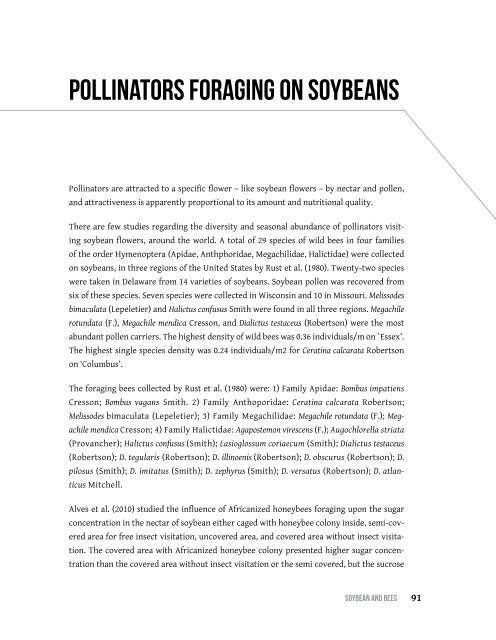Soybean and Bees
Create successful ePaper yourself
Turn your PDF publications into a flip-book with our unique Google optimized e-Paper software.
Pollinators foraging on soybeans<br />
Pollinators are attracted to a specific flower – like soybean flowers – by nectar <strong>and</strong> pollen,<br />
<strong>and</strong> attractiveness is apparently proportional to its amount <strong>and</strong> nutritional quality.<br />
There are few studies regarding the diversity <strong>and</strong> seasonal abundance of pollinators visiting<br />
soybean flowers, around the world. A total of 29 species of wild bees in four families<br />
of the order Hymenoptera (Apidae, Anthphoridae, Megachilidae, Halictidae) were collected<br />
on soybeans, in three regions of the United States by Rust et al. (1980). Twenty-two species<br />
were taken in Delaware from 14 varieties of soybeans. <strong>Soybean</strong> pollen was recovered from<br />
six of these species. Seven species were collected in Wisconsin <strong>and</strong> 10 in Missouri. Melissodes<br />
bimaculata (Lepeletier) <strong>and</strong> Halictus confusus Smith were found in all three regions. Megachile<br />
rotundata (F.), Megachile mendica Cresson, <strong>and</strong> Dialictus testaceus (Robertson) were the most<br />
abundant pollen carriers. The highest density of wild bees was 0.36 individuals/m on `Essex’.<br />
The highest single species density was 0.24 individuals/m2 for Ceratina calcarata Robertson<br />
on ‘Columbus’.<br />
The foraging bees collected by Rust et al. (1980) were: 1) Family Apidae: Bombus impatiens<br />
Cresson; Bombus vagans Smith. 2) Family Anthoporidae: Ceratina calcarata Robertson;<br />
Melissodes bimaculata (Lepeletier); 3) Family Megachilidae: Megachile rotundata (F.); Megachile<br />
mendica Cresson; 4) Family Halictidae: Agapostemon virescens (F.); Augochlorella striata<br />
(Provancher); Halictus confusus (Smith); Lasioglossum coriaecum (Smith); Dialictus testaceus<br />
(Robertson); D. tegularis (Robertson); D. illinoenis (Robertson); D. obscurus (Robertson); D.<br />
pilosus (Smith); D. imitatus (Smith); D. zephyrus (Smith); D. versatus (Robertson); D. atlanticus<br />
Mitchell.<br />
Alves et al. (2010) studied the influence of Africanized honeybees foraging upon the sugar<br />
concentration in the nectar of soybean either caged with honeybee colony inside, semi-covered<br />
area for free insect visitation, uncovered area, <strong>and</strong> covered area without insect visitation.<br />
The covered area with Africanized honeybee colony presented higher sugar concentration<br />
than the covered area without insect visitation or the semi covered, but the sucrose<br />
SoybeAn <strong>and</strong> bees<br />
91


